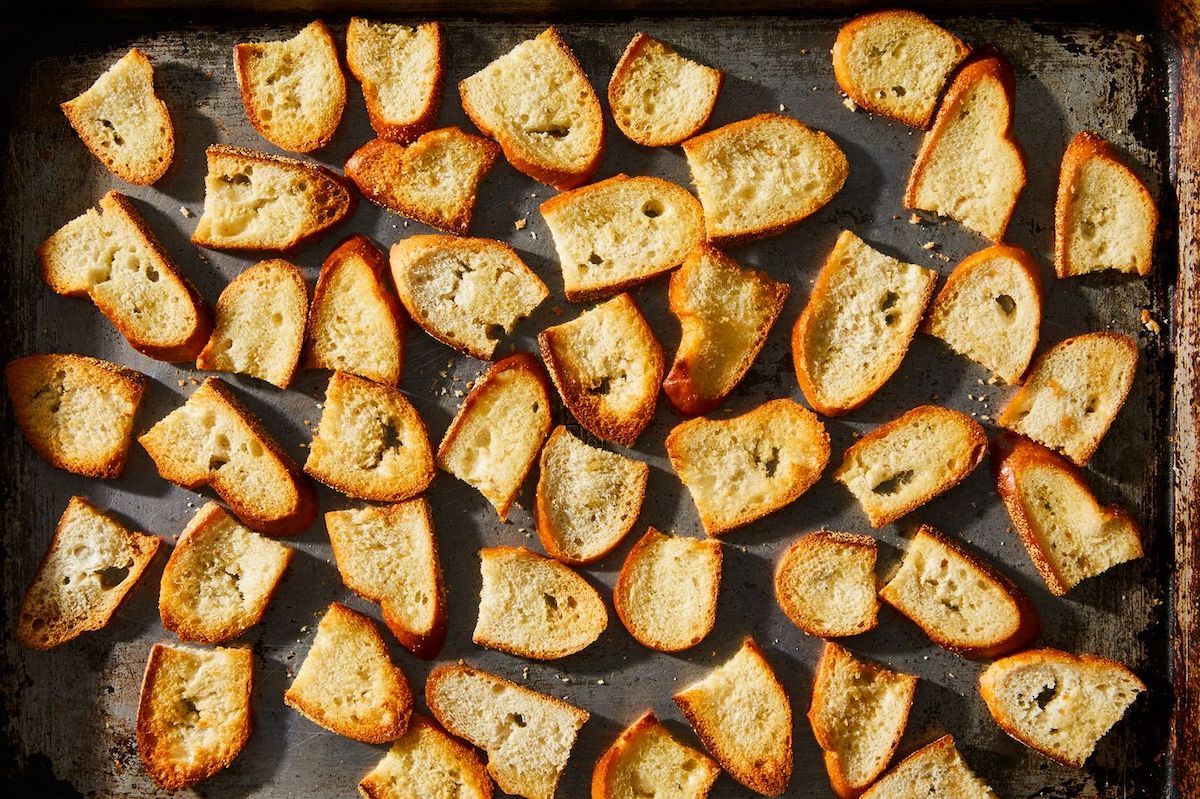Some of the most complex recipes have the fewest ingredients and steps — because there's nothing to hide behind. Success hinges on high-quality ingredients and excellent technique.
Which brings me to my biggest culinary pet peeve: sub-par crostini. When made well, these delicate toasts are a blank canvas with unlimited potential. Marcella Hazan defined them as "the easy-to-make Italian equivalent of croutons," but crostini require a high attention to detail.
As a chef, when I delegate crostini prep to another cook, I'm extremely specific on how to cut the bread, the temperature of the oven, and the cook time. Here's my guide to avoid common mistakes — and ensure your crostini are perfect every single time.
What Type Of Bread Works Best?
Ciabatta, sourdough, and rustic peasant bread can all be used to make crostini — just take care to cut each slice of bread into bite-size pieces. Avoid any bread that is especially dense, like certain whole-grain loaves. A dense bread may not toast well in the oven and could end up tasting slightly stale rather than crisp.
My personal preference: the best baguette I can find. Look for a baguette that has been freshly baked. The exterior should appear hearty and crunchy, with a slim shape that tapers at the ends. Avoid baguettes that seem bulbous or flabby.
How Should You Slice It?
First, focus on uniformity. If your bread is sliced inconsistently, then it will cook unevenly, with some pieces burning and others barely toasting. When working with a baguette, cut crosswise using a serrated knife, aiming for 1/4-inch thickness, the sweet spot between thick and thin.
When using a serrated knife to cut the bread, you don't need to exert downward pressure (this will crush the loaf). Trust the sharp teeth to do the work, maintaining a steady back-and-forth motion.
Make it bite-size: It's awkward to try to eat a crostino that's larger than one bite. Eat half and it can crumble on you. Stuff the whole thing in your mouth and you might look ridiculous. The solution is to halve each baguette slice.
The average slice of baguette is about 3 inches wide and 1 3/4 inches tall. Use a chef's knife to cut each slice in half. You're probably used to seeing whole slices of baguette turned into crostini, but these bite-size pieces are more elegant and easier to eat.
What About Oil And Seasonings?
A thin drizzle of oil will help your bread get crispy in the oven. Expect to use about 1 teaspoon of oil for every 8 crostini. The ingredient quality matters. If you have a favorite extra-virgin olive oil, this is a good time to use it. Varieties with grassy, peppery notes work great.
I tend to avoid adding salt to my crostini. If you're serving crostini with cheeses, cured meats, or other savory toppings, you likely won't need any added salt. Freshly cracked black pepper, however, can add a welcome layer of savory flavor. If you're in the mood, crack some pepper over the top of your crostini before baking.
Should You Bake Low-And-Slow Or Hot-And-Fast?
The ideal bite of crostini is uniformly crispy, with the tiniest hint of softness in the very center. This is achieved with a high heat and a relatively rapid cooking time. A lower heat and longer cook time result in crostini that taste too dry.
Pay close attention to the crostini while they cook. Undercooked crostini can have an unpleasant chewiness that feels almost stale, while overcooked crostini can taste brittle and may even hurt the roof of your mouth. Crostini can go from undercooked to overcooked in as little as a couple minutes. Perfectly cooked crostini will have golden-brown edges but pale centers.
Here's How To Make Crostini:
- Heat the oven to 450°F. Use a serrated knife to slice 1 baguette into ¼-inch thick pieces. Now use a chef's knife to halve each piece of bread.
- Line a rimmed sheet pan with a silicone baking mat or parchment paper. Arrange the bread slices in a single layer. (Don't overcrowd — you can use another lined sheet pan if needed.) Drizzle with olive oil (about 1 teaspoon of oil for every 8 crostini).
- Bake the crostini for 4 to 5 minutes. If you don't see any color, cook the crostini for 1 to 2 minutes longer. The crostini are done when the edges begin to turn brown but the center is still pale. Remove the crostini from the oven before they turn uniformly brown.
- Let the crostini cool to room temperature. They can be kept at room temperature in an airtight container for up to 48 hours.
Now What Are You Gonna Do With Them?
- Top with your favorite cured meats and cheeses. Try spicy soppressata and aged provolone. Or prosciutto and ricotta.
- Serve alongside any dips or spreads, like hummus or garlic yogurt.
- Decorate with seasonal veggies, from kale in the winter to fava beans in the spring.
- Rub with a raw garlic clove and use like croutons in soup or salad.
Have Ricotta (Or Another Creamy Cheese)? Perfect!
Related recipes:




Shares